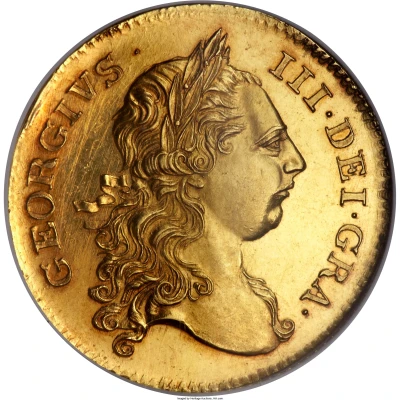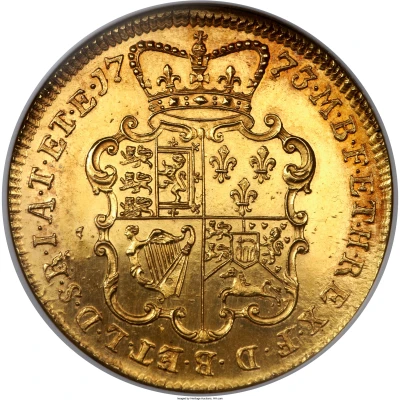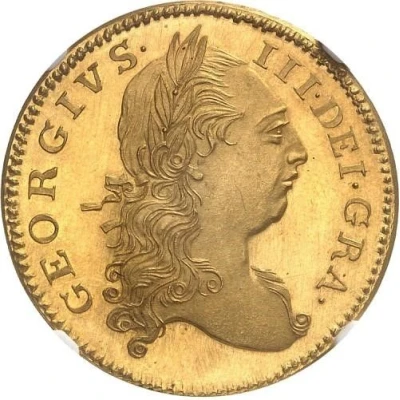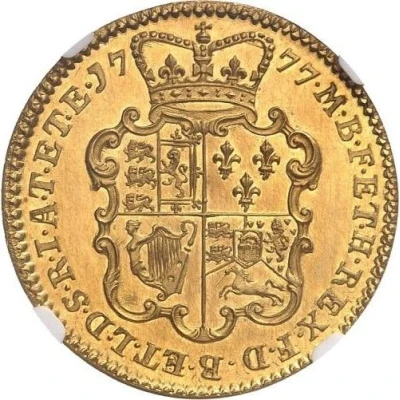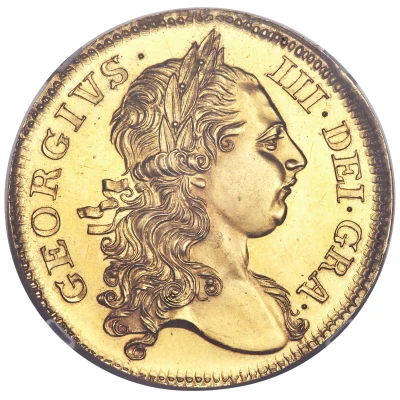
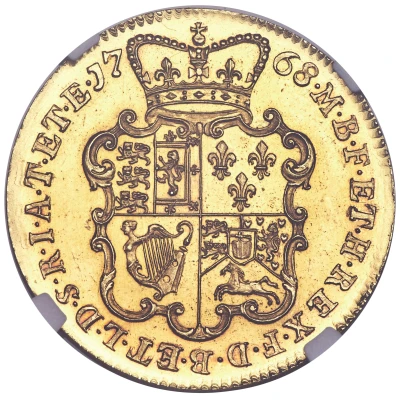

© Heritage Auctions
2 Guineas - George III Pattern
| Gold (.9167) | 16.8 g | 32 mm |
| Issuer | United Kingdom (United Kingdom, British Overseas Territories and Crown Dependencies) |
|---|---|
| King | George III (1760-1820) |
| Type | Pattern |
| Years | 1768-1777 |
| Value | 2 Guineas (2.1) |
| Currency | Pound sterling (1158-1970) |
| Composition | Gold (.9167) |
| Weight | 16.8 g |
| Diameter | 32 mm |
| Shape | Round |
| Technique | Milled |
| Orientation | Medal alignment ↑↑ |
| Demonetized | Yes |
| Updated | 2024-10-09 |
| Numista | N#181952 |
|---|---|
| Rarity index | 97% |
Reverse
Ornate crowned quartered shield of arms, divided date above, legend around.
Script: Latin
Lettering: M · B · F · ET · H · REX · F · D · B · ET · L · D · S · R · I · A · T · ET · E · 17 68 ·
Translation: King of Great Britain, France and Ireland, Defender of the Faith, Duke of Brunswick and Lueneburg, Arch Treasurer and Elector of the Holy Roman Empire
Engraver: J.S. Tanner
Edge
Plain
Comment
The pattern 2 and 5 Guinea pieces of George III are somewhat enigmatic. The singular Guinea coins began to be issued almost immediately after George took the throne, as did the Half and Quarter Guineas. Meanwhile, patterns were produced for 2 Guinea pieces in 1768, 1773 and 1777, and for 5 Guineas in 1770, 1773 and 1777. Clearly several attempts were made to strike these larger gold pieces for circulation - but they never saw widespread production. This is likely because the overvaluation of British gold coinage in the 18th century meant that it was the only metal fairly certain to remain in domestic circulation whilst the undervalued silver and copper was sold abroad. Previously only widely used by the wealthy, gold was suddenly necessary for day-to-day transactions even amongst the less well-off in society and as such was more useful in smaller, more manageable fractions as opposed to larger pieces (substantiated by the introduction of the hitherto unheard of Third Guinea in 1797). Accordingly, the 2 and 5 Guinea pieces were doomed to remain as patterns, the final multiple Guineas ever produced before being eventually replaced by the 2 and 5 Pounds in 1820.Produced in 1768, this piece represents the very first attempt to produce a higher-value gold denomination during George III's reign, predating the first 5 Guinea pattern by two years. Indeed, its engraving appears to be far finer than the later 1773 and 1777 types, and on the same level as the 1770 5 Guineas, implying that as time went on the pattern quality dropped for each denomination.
There are six different bust varieties for the 2 and 5 Guinea patterns, for further details see Wilson & Rasmussen
Interesting fact
One interesting fact about the Pattern 2 Guineas - George III (Pattern) 1768-1777 from United Kingdom is that it was designed by acclaimed artist and engraver, Thomas Pingo. Pingo was known for his exceptional craftsmanship and attention to detail, which is evident in the intricate design of this coin. The coin features a portrait of King George III on one side and a detailed image of a crowned shield on the other, showcasing Pingo's skill and artistry.
Price
| Date | Mintage | VG | F | VF | XF | AU | UNC |
|---|---|---|---|---|---|---|---|
| 1768 | - | - | - | - | - | - |
Values in the table are based on evaluations by sales realized on Internet platforms. They serve as an indication only for 2 Guineas - George III (Pattern) 1768-1777 coin.
